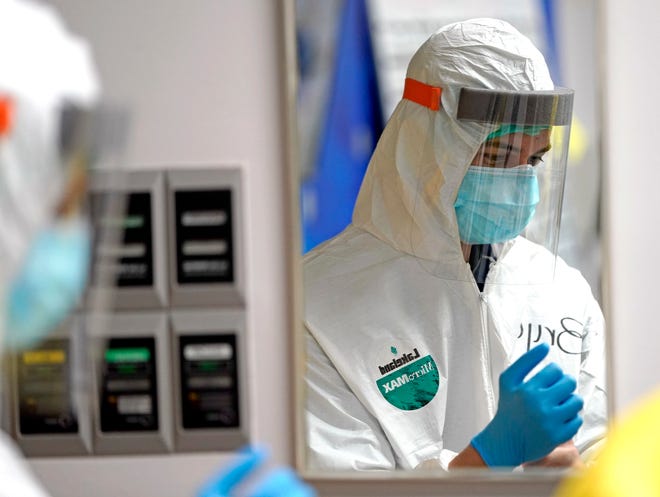How Many People Can Go at Prividebce Prefiring Arts
David J. Skorton and Lisa Howley
As the new year begins, science occupies center stage — as it did through almost of 2020. The COVID-19 pandemic has seen to that. Enquiry that once would take been confined to labs is now front-folio news; the public hangs on the latest results of clinical trials and compares the efficacy rates of vaccines.
The hope that many of us accept begun to feel today — every bit extraordinarily effective and prophylactic vaccines accomplish the front lines of this fight — underscores the importance of science. For 2021 to be brighter than final year, science and scientists must continue to play their indispensable roles, and must be taken seriously.
Withal science in itself is insufficient to the task ahead. The continuing challenges posed by the virus become well beyond the answers that science can possibly provide. For example, research can identify the huge disparities in COVID'southward touch among people of unlike races, ethnicities and types of work, simply information technology cannot eliminate them. Neither is there a scientific quick-fix for vaccine hesitancy — the reluctance of many Americans to have any vaccine, however constructive.
In addressing these issues, among others, club needs the work of scientists and health professionals to be informed by, and infused with, a wide range of homo insight, feel and values. We demand not but science but as well the arts and humanities — and a union between them.

As no less a mathematician than Albert Einstein put it: "All religions, arts and sciences are branches of the same tree" because all serve the same larger purpose — to uplift the lives of human beings.
This is not a new idea. The principle that Einstein expressed has its roots in the Renaissance and the Enlightenment; and medicine, in particular, has always been both an art and a scientific discipline.
Inquiry supports arts education
In historical terms, our present era of hyper-specialization in medicine and far beyond is an anomaly. And so is the de-accent we're seeing on liberal arts programs in favor of science, applied science and other disciplines that promise a greater bang for the buck, vocationally speaking.
Just today, perhaps more than ever, health professionals must exist able to draw from many disciplines. Physicians and other caregivers operate in a complex, chop-chop changing environment. To practice effectively — to best serve our patients — our knowledge of scientific advances needs to be reinforced past qualities that are emphasized in the arts and humanities: imagination and curiosity, communication and empathy, critical thinking and social advancement.
That is truthful, for example, when it comes to decisions concerning the finish of life. This was brought home to one of us, painfully then, years ago in a infirmary in Iowa. An electroencephalogram determined that a patient no longer showed any brain activeness. Nonetheless in the stop, the difficult conclusion to remove her life support drew less on science than on medical ethics, communication with family members and human pity.
Studying the arts and humanities helps develop important habits of mind; it heightens our understanding of one another, of the human condition. It is not surprising, therefore, that several studies have institute that medical students, doctors and nurses who participate in arts-based training — closely studying artwork at museums, for example — meet improvements in their clinical observation and communication skills.
Humanities assistance build empathy
One multi-institution report showed that medical students who take had greater exposure to the humanities receive much higher scores in empathy, tolerance for ambiguity and emotional intelligence — all qualities that any of us would want in a physician.
In 2018, the National Academies of Science, Engineering, and Medicine issued a written report, "Branches from the Same Tree," an echo of Einstein. The group recommended that institutions of higher learning develop curricula that integrate the arts and sciences. Toward that terminate, medical schools and pedagogy hospitals are placing greater emphasis on the arts and humanities in educating the next generation of physicians.
And terminal month, our organization issued guidance to further this trend. Schools could take a variety of approaches: they could, say, comprise the humanities to teach medical students about the affect that America's history of systemic racism has on today's health inequities, or could utilise the arts to train clinicians to communicate the value of science to the communities they serve.
Of form, health professionals are non the only group that would gain from greater engagement with the arts and humanities. Surely we would all do good from learning new ways of thinking, new ways of understanding our cultural differences and our mutual humanity.
Every bit long as the pandemic cuts a deadly path across our earth, science will of course be paramount. But none of our institutions — and that includes authorities at all levels —should see the arts and humanities every bit frills. They are essential to our welfare — even our survival. The arts can not simply assist heal our bodies during these difficult times, they can help heal our souls.
David J. Skorton, M.D., is president and CEO of the Association of American Medical Colleges and a member of the USA TODAY Lath of Contributors. Lisa Howley, Ph.D.,is senior managing director of Strategic Initiatives and Partnerships at the AAMC.
crouchthosinglone.blogspot.com
Source: https://www.usatoday.com/story/opinion/2021/01/06/why-arts-have-essential-role-during-covid-19-pandemic-column/4138588001/
0 Response to "How Many People Can Go at Prividebce Prefiring Arts"
Enregistrer un commentaire